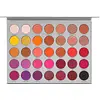What's inside
What's inside
 Key Ingredients
Key Ingredients

 Benefits
Benefits

No benefits
 Concerns
Concerns

 Ingredients Side-by-side
Ingredients Side-by-side

Talc
AbrasiveTriisostearin
Skin ConditioningHydrogenated Polydecene
EmollientMagnesium Stearate
Cosmetic ColorantSynthetic Wax
AbrasiveCalcium Sodium Borosilicate
Hdi/Trimethylol Hexyllactone Crosspolymer
Synthetic Fluorphlogopite
Caprylyl Glycol
EmollientSilica
AbrasiveCalcium Aluminum Borosilicate
Perlite
AbsorbentTin Oxide
AbrasiveAlumina
AbrasiveMagnesium Silicate
AbsorbentMica
Cosmetic ColorantCI 77891
Cosmetic ColorantCI 77491
Cosmetic ColorantCI 77492
Cosmetic ColorantCI 77499
Cosmetic ColorantCI 77400
Cosmetic ColorantCI 77742
Cosmetic ColorantCI 77000
Cosmetic ColorantCI 77007
Cosmetic ColorantCI 77163
Cosmetic ColorantCI 75470
Cosmetic ColorantCI 77510
Cosmetic ColorantCI 19140
Cosmetic ColorantCI 77288
Cosmetic ColorantCI 16035
Cosmetic ColorantCI 42090
Cosmetic ColorantTalc, Triisostearin, Hydrogenated Polydecene, Magnesium Stearate, Synthetic Wax, Calcium Sodium Borosilicate, Hdi/Trimethylol Hexyllactone Crosspolymer, Synthetic Fluorphlogopite, Caprylyl Glycol, Silica, Calcium Aluminum Borosilicate, Perlite, Tin Oxide, Alumina, Magnesium Silicate, Mica, CI 77891, CI 77491, CI 77492, CI 77499, CI 77400, CI 77742, CI 77000, CI 77007, CI 77163, CI 75470, CI 77510, CI 19140, CI 77288, CI 16035, CI 42090
Calcium Sodium Borosilicate
Mica
Cosmetic ColorantSynthetic Fluorphlogopite
Phenyl Trimethicone
Skin ConditioningEthylhexyl Palmitate
EmollientIsononyl Isononanoate
EmollientTridecyl Trimellitate
EmollientMagnesium Myristate
Silica
AbrasiveIsostearyl Isostearate
EmollientNylon-12
Magnesium Stearate
Cosmetic ColorantBoron Nitride
AbsorbentPolyethylene
AbrasiveTocopheryl Acetate
AntioxidantSimmondsia Chinensis Seed Oil
EmollientCocos Nucifera Oil
MaskingButyrospermum Parkii Butter
Skin ConditioningTin Oxide
AbrasiveCaprylyl Glycol
EmollientEthylhexylglycerin
Skin ConditioningPhenoxyethanol
PreservativeCI 77891
Cosmetic ColorantIron Oxides
CI 15850
Cosmetic ColorantCI 75470
Cosmetic ColorantCI 77007
Cosmetic ColorantCI 19140
Cosmetic ColorantCalcium Sodium Borosilicate, Mica, Synthetic Fluorphlogopite, Phenyl Trimethicone, Ethylhexyl Palmitate, Isononyl Isononanoate, Tridecyl Trimellitate, Magnesium Myristate, Silica, Isostearyl Isostearate, Nylon-12, Magnesium Stearate, Boron Nitride, Polyethylene, Tocopheryl Acetate, Simmondsia Chinensis Seed Oil, Cocos Nucifera Oil, Butyrospermum Parkii Butter, Tin Oxide, Caprylyl Glycol, Ethylhexylglycerin, Phenoxyethanol, CI 77891, Iron Oxides, CI 15850, CI 75470, CI 77007, CI 19140
Ingredients Explained
These ingredients are found in both products.
Ingredients higher up in an ingredient list are typically present in a larger amount.
Calcium Sodium Borosilicate is a bulking agent. It is considered a borosilicate glass; it is composed of powder or flakes of calcium and sodium borosilicates.
This ingredient is used to add volume, shine, and color to products. You'll most likely find this ingredient in makeup products.
According to in-vivo and ex-vivo studies done by a manufacturer, this ingredient works well with UV filters:
Learn more about Calcium Sodium BorosilicateCaprylyl Glycol is a humectant and emollient, meaning it attracts and preserves moisture.
It is a common ingredient in many products, especially those designed to hydrate skin. The primary benefits are retaining moisture, skin softening, and promoting a healthy skin barrier.
Though Caprylyl Glycol is an alcohol derived from fatty acids, it is not the kind that can dry out skin.
This ingredient is also used as a preservative to extend the life of products. It has slight antimicrobial properties.
Learn more about Caprylyl GlycolCI 19140 is also known as Tartrazine. Tartrazine is a synthetic dye used in cosmetics, foods, and medicine to add a yellow color.
Tartrazine is created from petroleum and is water-soluble.
Some people may experience allergies from this dye, especially asthmatics and those with an aspirin intolerance.
Learn more about CI 19140Ci 75470 is a bright-red pigment. It is AKA carmine.
Carmine is derived from insects such as the cochineal beetle. This ingredient has been used as a natural dye for over 2000 years.
This pigment is called Ultramarine blue lazurite. It gives a saturated blue color, but can be used to create other colors as well.
According to the manufacturer, it is usually made from kaolin, sodium sulfate, sodium carbonate, sulfur, and charcoal.
Ci 77891 is a white pigment from Titanium dioxide. It is naturally found in minerals such as rutile and ilmenite.
It's main function is to add a white color to cosmetics. It can also be mixed with other colors to create different shades.
Ci 77891 is commonly found in sunscreens due to its ability to block UV rays.
Learn more about CI 77891Magnesium Stearate is a salt that is 2 parts stearic acid and 1 part magnesium.
It is a white powder that can be used to add bulk and color to products by binding to oil ingredients.
Mica is a naturally occurring mineral used to add shimmer and color in cosmetics. It can also help improve the texture of a product or give it an opaque, white/silver color.
Serecite is the name for very fine but ragged grains of mica.
This ingredient is often coated with metal oxides like titanium dioxide. Trace amounts of heavy metals may be found in mica, but these metals are not harmful in our personal products.
Mica has been used since prehistoric times throughout the world. Ancient Egyptian, Indian, Greek, Roman, Aztec, and Chinese civilizations have used mica.
Learn more about MicaSilica, also known as silicon dioxide, is a naturally occurring mineral. It is used as a fine, spherical, and porous powder in cosmetics.
Though it has exfoliant properties, the function of silica varies depending on the product.
The unique structure of silica enhances the spreadability and adds smoothness, making it a great texture enhancer.
It is also used as an active carrier, emulsifier, and mattifier due to its ability to absorb excess oil.
In some products, tiny microneedles called spicules are made from silica or hydrolyzed sponge. When you rub them in, they lightly polish away dead skin layers and enhance the penetration of active ingredients.
Learn more about SilicaSynthetic Fluorphlogopite is the synthethic version of mica. It consists of fluorine, aluminum and silicate.
Synthetic Fluorphlogopite is used to add volume to products.
It is considered non-irritating on the skin.
Learn more about Synthetic FluorphlogopiteTin Oxide is an inorganic oxide used to add opacity and volume to a product. In nature, it is already found in mineral form. The main ore of tin is an opaque and shiny mineral called casseterite.
Tin Oxide helps remove translucency in a product, or make it more opaque. Besides adding opacity, tin oxide is used for bulking to add volume.